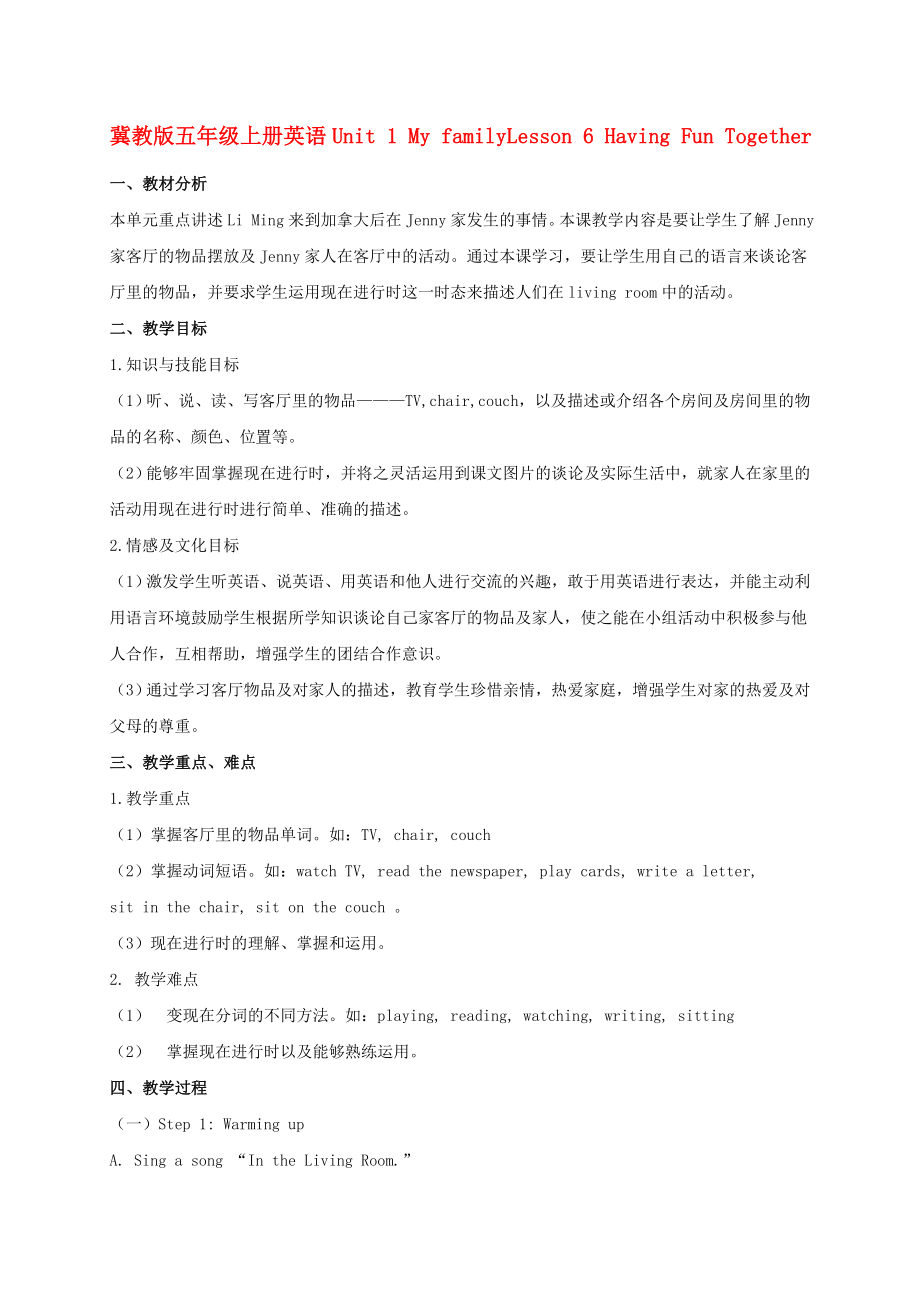《五年級英語上冊 Unit 1 My familyLesson 6 Having Fun Together教案 冀教版》由會員分享,可在線閱讀����,更多相關(guān)《五年級英語上冊 Unit 1 My familyLesson 6 Having Fun Together教案 冀教版(3頁珍藏版)》請?jiān)谘b配圖網(wǎng)上搜索。
1�����、冀教版五年級上冊英語Unit 1 My familyLesson 6 Having Fun Together
一���、教材分析
本單元重點(diǎn)講述Li Ming來到加拿大后在Jenny家發(fā)生的事情���。本課教學(xué)內(nèi)容是要讓學(xué)生了解Jenny家客廳的物品擺放及Jenny家人在客廳中的活動。通過本課學(xué)習(xí)����,要讓學(xué)生用自己的語言來談?wù)摽蛷d里的物品�����,并要求學(xué)生運(yùn)用現(xiàn)在進(jìn)行時(shí)這一時(shí)態(tài)來描述人們在living room中的活動����。
二�����、教學(xué)目標(biāo)
1.知識與技能目標(biāo)
(1)聽��、說��、讀�、寫客廳里的物品———TV,chair,couch�,以及描述或介紹各個(gè)房間及房間里的物品的名稱、顏色����、位置等。
(2)能夠牢固掌握現(xiàn)
2���、在進(jìn)行時(shí)���,并將之靈活運(yùn)用到課文圖片的談?wù)摷皩?shí)際生活中����,就家人在家里的活動用現(xiàn)在進(jìn)行時(shí)進(jìn)行簡單��、準(zhǔn)確的描述��。
2.情感及文化目標(biāo)
(1)激發(fā)學(xué)生聽英語��、說英語�、用英語和他人進(jìn)行交流的興趣,敢于用英語進(jìn)行表達(dá)��,并能主動利用語言環(huán)境鼓勵(lì)學(xué)生根據(jù)所學(xué)知識談?wù)撟约杭铱蛷d的物品及家人����,使之能在小組活動中積極參與他人合作,互相幫助���,增強(qiáng)學(xué)生的團(tuán)結(jié)合作意識�����。
(3)通過學(xué)習(xí)客廳物品及對家人的描述�,教育學(xué)生珍惜親情,熱愛家庭�����,增強(qiáng)學(xué)生對家的熱愛及對父母的尊重�。
三、教學(xué)重點(diǎn)�、難點(diǎn)
1.教學(xué)重點(diǎn)
(1)掌握客廳里的物品單詞。如:TV, chair, couch
(2)掌握動詞短語�。如:watch T
3、V, read the newspaper, play cards, write a letter,
sit in the chair, sit on the couch �����。
(3)現(xiàn)在進(jìn)行時(shí)的理解��、掌握和運(yùn)用���。
2. 教學(xué)難點(diǎn)
(1)?變現(xiàn)在分詞的不同方法。如:playing, reading, watching, writing, sitting
(2)?掌握現(xiàn)在進(jìn)行時(shí)以及能夠熟練運(yùn)用���。
四�、教學(xué)過程
(一)Step 1: Warming up
A. Sing a song “In the Living Room.”
B.?Revision
T: Where do
4、you live? I live in a house. Here’s my house. How many rooms? Guess what room is it.
S1, S2, S3, S4: This is a bedroom/ living room/ kitchen/ bathroom.
T: I have something for my house. I want you to put them in the correct room.
??? 設(shè)計(jì)意圖:“萬事開頭難”����。一節(jié)課的導(dǎo)入必須要自然、輕松����,針對本節(jié)課的教學(xué)內(nèi)容,教師與學(xué)生同唱一首“In the Bathro
5�、om”。通過演唱和表演��,共同創(chuàng)造了一個(gè)和諧的課堂氛圍�。通過一個(gè)物品找房間的活動來復(fù)習(xí)本單元的重點(diǎn)詞匯,激發(fā)了學(xué)生學(xué)習(xí)英語的興趣�����,使學(xué)生盡快進(jìn)入了學(xué)習(xí)狀態(tài)���。
(二)? Step 2: New Teaching.
T: There is a ___, a ___ and _____in the bedroom/kitchen/bathroom. But there’s nothing in the living room. Guess what’s in my living room.(出示電視�、小沙發(fā)��、長沙發(fā)的模型)
T: I want to watch TV. (指黑板)Is this
6、 a TV?
Ss: No, this isn’t a TV. This is a blackboard.
T: (指椅子)Is this a TV�����?
Ss: No, this isn’t a TV. This is a chair.
T: Where is the TV��?
S1: Here’s the TV.
T: (出示 Jenny家客廳的圖片課件)What can you find in the living room?
S1: This is a ____.
S2: These are ____.
S3: I see _____.
S4: I like _____.
7��、
T: What do you do in the living room?(選擇和本課有關(guān)的短語板書)
??? 設(shè)計(jì)意圖:在幫助物品找房間的活動結(jié)束之際詢問學(xué)生客廳里有什么��,順便引出了本課的重點(diǎn)生詞chair, TV和couch��,起到了一箭雙雕的雙重作用�����。通過對Jenny家客廳的反復(fù)談?wù)?���,既突出了趣味性,又給學(xué)生提供了獲取成功和自信的機(jī)會����,使這些詞匯深深印在了學(xué)生的腦海里�����,為下一步的學(xué)習(xí)提供了良好的心理準(zhǔn)備。What do you do in the living room��?這是個(gè)拓展性很強(qiáng)的問題���,這會使學(xué)生的語言自然流露��,使語言與實(shí)際生活緊密聯(lián)系���。
(三)? Step 3: Game
8、
教師讓一個(gè)學(xué)生看動詞短語�,然后做動作,其他同學(xué)回答What is he/she doing? What are you/they doing? 和What am I doing?��。 教師把黑板上的短語變成現(xiàn)在進(jìn)行時(shí)的句子����。
T: Today we’ll meet a new friend. (出示現(xiàn)在進(jìn)行時(shí)自我介紹的課件)
T: (出示Jenny家客廳的圖片) Ask and answer about the picture.
設(shè)計(jì)意圖:為了突破本課的教學(xué)重點(diǎn)—— 現(xiàn)在進(jìn)行時(shí),教師特別設(shè)計(jì)了游戲活動——look and do the action����。一方面調(diào)動了學(xué)生們的學(xué)習(xí)熱情,激發(fā)學(xué)
9��、生的創(chuàng)造性思維,另一方面通過用What’s he/she doing? What are they/you doing? What am I doing? 等不同人稱的提問��,講解了各種人稱句式���,進(jìn)行了層次化的語言訓(xùn)練�。
(四)?Step 4: Consolidation
T: Listen to the tape and answer the question “ Is everyone in the living room quiet?”
(學(xué)生有目的的去聽課文���。)
OK, answer the question.(讓學(xué)生回答問題���。)
T: Take out your listen
10、ing paper, listen and fill the blanks.
(主要是針對現(xiàn)在進(jìn)行分詞的練習(xí))
Listen, repeat and check your answers.
??? 設(shè)計(jì)意圖:引入課文教學(xué)���,每一遍聽磁帶朗讀都讓學(xué)生帶著不同任務(wù)有目的的去聽�。同時(shí)進(jìn)行了寫的訓(xùn)練�,培養(yǎng)學(xué)生在聽錄音時(shí)善于抓住關(guān)鍵詞的習(xí)慣。
(五)?Step 5: Activities
T: Show a picture of your living room and talk about it with your partner.
(六)?Step 6: Homework
T: Talk about your living room with your friends and your family.
??? 設(shè)計(jì)意圖:語言的形成和發(fā)展��,僅憑課本教學(xué)是不夠的�。結(jié)合本課教學(xué)內(nèi)容,讓學(xué)生在小組中討論自己家的客廳����,既是對本課知識的外延�,又幫助學(xué)生在實(shí)際生活中運(yùn)用語言�,培養(yǎng)學(xué)生的語言綜合運(yùn)用能力�����。真正遵循 “為用而學(xué)�,在用中學(xué),學(xué)了就用”的教學(xué)原則��。
 五年級英語上冊 Unit 1 My familyLesson 6 Having Fun Together教案 冀教版
五年級英語上冊 Unit 1 My familyLesson 6 Having Fun Together教案 冀教版

